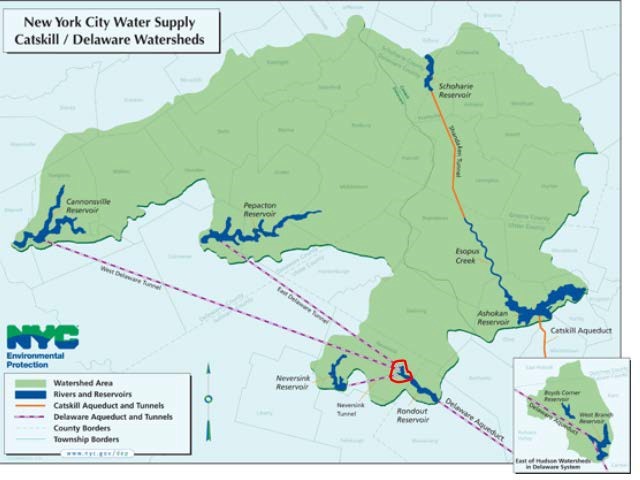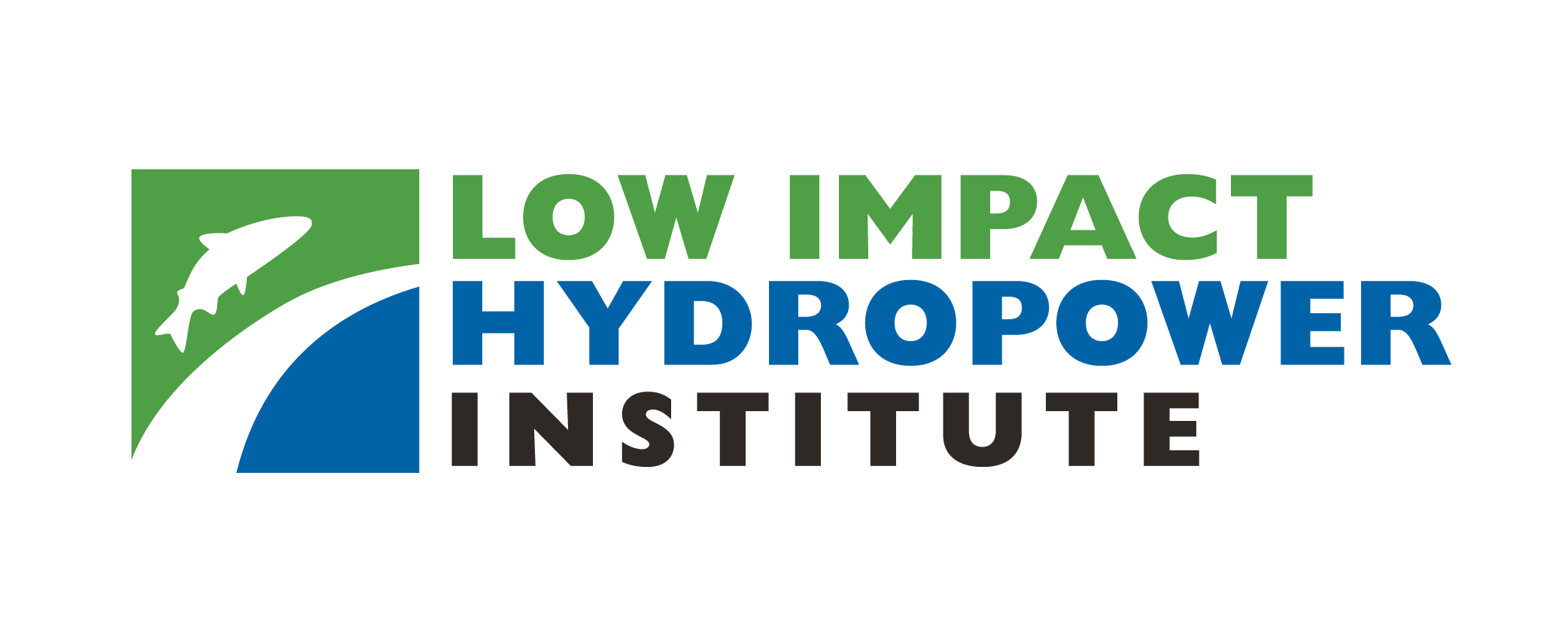Certificat LIHI #151 – Projet de tunnel du West Delaware, New York

| Nom du projet | Tunnel du Delaware Ouest |
| Numéro de certificat LIHI |
151 |
| Durée du certificat LIHI |
29 mars 2019 – 28 mars 2034 |
| Propriétaire | West Delaware Hydropower Associates, LP, une filiale de Brookfield Renewable Energy Group |
| État | New York |
| Emplacement | Aqueduc de l'ouest du Delaware |
| Capacité installée | 7,5 MW |
| Génération annuelle moyenne | 26 400 MWh |
| Type d'établissement | Conduit |
| Fédération internationale de radio-télévision (FERC) Non. | P-9159 exempté 1986 |
Le projet de tunnel du West Delaware est situé près de Grahamsville, dans le comté de Sullivan, dans l'État de New York, sur un terrain appartenant au Département de la protection de l'environnement de la ville de New York (NYCDEP) et faisant partie de son aqueduc du West Delaware, qui alimente la ville en eau potable. Le projet est situé sur l'aqueduc reliant Rondout. Réservoir et le réservoir de Cannonsville. Le projet a été construit en 1987, plusieurs décennies après la construction des deux réservoirs, respectivement en 1950 et 1964.
Le projet comprend un tunnel de 60 pieds de long et de 66 pouces de diamètre conduite forcée et un centraleLe propriétaire dispose d'une servitude d'usage de la propriété. La centrale électrique comprend une section verticale. Turbine Francis/générateur d'une capacité de 7,5 MW. L'eau est dérivée de l'aqueduc de West Delaware vers la conduite forcée enterrée qui achemine l'eau jusqu'à la turbine de la centrale. L'eau est rejetée dans un piscine de tranquillisation (utilisé pour réduire la vitesse de l'eau) qui se déverse à son tour dans le réservoir de Rondout.
Le projet fonctionne comme une installation de canalisation. Chaque semaine, le NYCDEP envoie une allocation d'eau en fonction des besoins en eau de la ville de New York. Le système du NYCDEP détermine l'allocation hebdomadaire en fonction de plusieurs facteurs, notamment le niveau des réservoirs, les prévisions d'afflux, la climatologie et la qualité de l'eau. Si une allocation est fournie par le NYCDEP, le maître d'ouvrage déterminera ensuite le débit et le calendrier nécessaires pour fournir l'allocation demandée sur la période spécifiée. En règle générale, le projet fera fonctionner sa turbine à son rendement optimal afin de maximiser la puissance pendant une période donnée. culminant calendrier.
Les eaux situées dans le périmètre du projet sont classées eau potable de classe AA. Les réservoirs associés sont tous deux contaminés par le mercure provenant des dépôts atmosphériques, et le réservoir de Cannonsville est classé pour le phosphore provenant de sources agricoles et municipales. En tant qu'installation de canalisation, le projet n'a aucun impact sur la qualité de l'eau.
Le projet ne crée pas d’obstacle à passage des poissons Aucun poisson migrateur ne devrait être affecté par l'eau qui coule dans l'aqueduc. Les deux réservoirs sont ensemencés chaque année de truites brunes, de touladis et de truites arc-en-ciel, et des populations naturelles de gaspareaux et d'éperlans peuvent être observées dans le réservoir Rondout grâce à son affluent (ruisseau Rondout).
La centrale est située sur un terrain clôturé d'une superficie d'environ 3 700 m². Le projet ne comporte aucune terre présentant une valeur écologique significative, en raison de son caractère artificiel.
Parmi les espèces potentiellement menacées et en voie de disparition présentes à proximité du projet figure le pygargue à tête blanche. Un nid de pygargue à tête blanche a été observé à environ 150 mètres des limites du site. La seule préoccupation identifiée concernait la conception des lignes de transport d'électricité pour éviter les risques d'électrocution associés au projet. Le Service américain de la pêche et de la faune sauvage a soulevé cette préoccupation, mais les lignes de transport d'électricité ne sont pas sous la responsabilité du projet.
Le propriétaire du projet a consulté la Division de la préservation historique de l'État de New York, qui a conclu qu'aucune propriété historique n'était affectée par les opérations du projet.
La centrale est une zone sécurisée et clôturée, interdite au public. Les loisirs au réservoir Rondout, situé à proximité, sont strictement contrôlés et gérés par le NYCDEP, car il sert à l'approvisionnement en eau potable.
État de conformité
Il n’y a pas de conditions spécifiques à l’établissement dans le certificat actuel.
2025: Aucun changement important ni problème de conformité n'ont été identifiés. Le projet reste conforme sur la base de l'examen annuel.
2024: Aucun changement important ni problème de conformité n'ont été identifiés. Le projet reste conforme sur la base de l'examen annuel.
2023: Aucun changement important ni problème de conformité n'ont été identifiés. Le projet reste conforme sur la base de l'examen annuel.
2022: Aucun changement important ni problème de conformité n'ont été identifiés. Le projet reste conforme sur la base de l'examen annuel.
2021: Aucun changement ni problème de conformité n'a été signalé. Le projet reste conforme sur la base de l'examen annuel.
2020: Aucun changement ni problème de conformité n'a été signalé. Le projet reste conforme sur la base de l'examen annuel.
2019: Le rapport annuel pour le certificat actuel n’est pas encore entré en vigueur.
Historique des certifications
1er janvier 2022 : La durée du certificat LIHI a été prolongée conformément à la révision 2.05 du manuel de certification LIHI 2e édition publié le 1er janvier 2022. Reportez-vous au tableau des établissements ci-dessus pour connaître la nouvelle durée.
16 juillet 2019 : La décision de certification du projet hydroélectrique du tunnel de West Delaware est définitive. Aucun appel n'a été reçu pendant la période d'appel, clôturée le 13 juillet 2019. La nouvelle période de certification du projet s'étend du 29 mars 2019 au 28 mars 2029.
12 juin 2019 : Le Low Impact Hydropower Institute (LIHI) a approuvé de manière préliminaire la certification à faible impact pour le projet hydroélectrique du tunnel de l'ouest du Delaware.
Cette décision est préliminaire en attendant la période d'appel de 30 jours. Seuls ceux qui ont commenté la demande initiale pendant la période de commentaires de 60 jours sont éligibles pour déposer un appel. Un tel appel doit inclure une explication sur la raison pour laquelle le projet ne répond pas aux critères du LIHI. Les demandes d'appel peuvent être soumises par courrier électronique à commentaires@lowimpacthydro.org avec « Projet hydroélectrique du tunnel de West Delaware » en objet, ou par courrier adressé au Low Impact Hydropower Institute, 329 Massachusetts Ave, Suite 6, Lexington, MA 02420. Toutes les demandes seront publiées sur le site web. Le demandeur aura la possibilité de répondre, et toute réponse sera également publiée. Les demandes doivent être reçues avant 17 h, heure de l’Est, le 13 juillet 2019. Le dossier complet et le rapport des évaluateurs sont disponibles ci-dessous.
Si aucune demande d'appel n'est reçue et que la décision devient définitive, la période de certification du projet (en attente de LIHI #151) sera du 29 mars 2019 au 28 mars 2029.
2 avril 2019 :Le Low Impact Hydropower Institute a reçu une demande complète de certification à faible impact pour le projet hydroélectrique du tunnel du West Delaware. Le LIHI sollicite les commentaires du public sur cette demande. Plus précisément, nous souhaitons savoir si, selon vous, le projet répond aux critères de certification à faible impact du LIHI, tels que révisés dans la 2e édition du manuel. Veuillez consulter le programme et les critères dans la version révisée du LIHI. Manuel et consultez ensuite les documents de candidature du projet ci-dessous.
Les commentaires directement liés à des critères spécifiques du LIHI (débits, qualité de l'eau, passage des poissons, etc.) seront les plus utiles, mais tous les commentaires seront pris en compte. Les commentaires peuvent être envoyés à l'Institut par courrier électronique à l'adresse commentaires@lowimpacthydro.org avec « Commentaires sur le projet de tunnel de l'ouest du Delaware » dans la ligne d'objet, ou par courrier adressé au Low Impact Hydropower Institute, 329 Massachusetts Avenue, Suite 6, Lexington, MA 02420. Les commentaires doivent être reçus au plus tard à 17 h, heure de l'Est, le 1er juin 2019. à prendre en considération. Tous les commentaires seront publiés sur le site Web et le candidat aura la possibilité d'y répondre. Toute réponse sera également publiée.
Dossiers de certification
Certification 2019
- Rapport d'examen de la certification du tunnel de l'ouest du Delaware 2019
- Demande de certification de l'ouest du Delaware
- Tunnel du West Delaware FERC Exemption 1986
